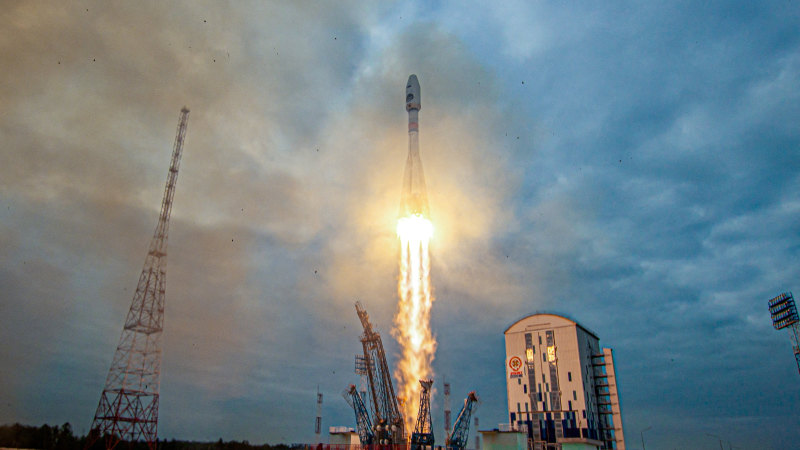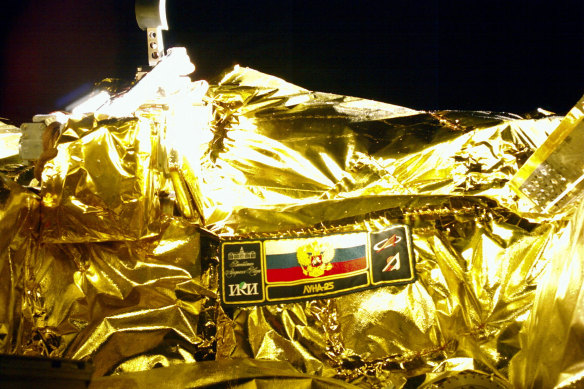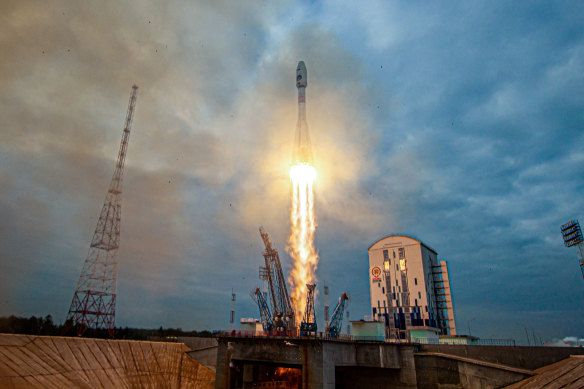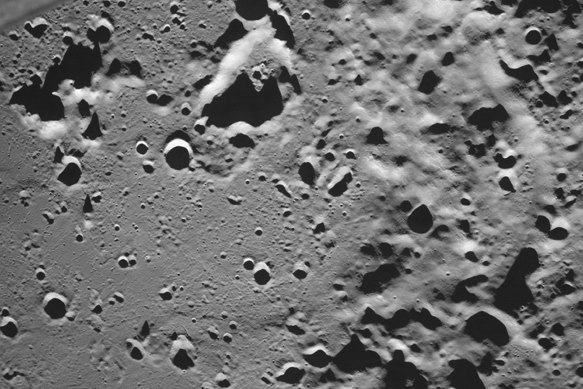Save articles for later
Add articles to your saved list and come back to them any time.
Russia’s hopes of once again dominating lunar exploration literally came crashing down into the moon at the weekend, bringing home a bitter truth that its space program is not what it once was.
More than 60 years on from its Soviet era heyday – launching the first dog and then the first man into space – Russia is lagging behind old and new global competitors embarking on a new race for the moon.
“Over the past decade, if not more, they haven’t been as ambitious, they haven’t been doing as many missions and there’s been a general [loss] of expertise and investment,” said Australian National University astrophysicist and cosmologist Brad Tucker.
A picture taken from the camera of the lunar landing spacecraft Luna-25 during its flight to the moon shows the mission emblem and the bucket of the lunar manipulator complex.Credit: Reuters
“The space race of today, it’s nothing like in the 60s and 70s. Then, it was a two horse race with one goal. Now there are multiple horses and multiple races. And if you’re not trying to compete…what are you doing?”
The pilotless Lunar 25 launched earlier this month on a mission to be the first spacecraft to land on the moon’s south pole, where scientists expect to find precious elements and suspected reserves of frozen water.
Lunar-25 did manage to capture imagery and data during its journey; however, it ultimately failed when the vehicle spun into an uncontrolled orbit and crashed into the surface of the moon on Saturday.
Luna-25 blasts off from a launchpad at the Vostochny Cosmodrome in the far eastern Amur region, Russia.Credit: Reuters
Roscosmos Director General Yury Borisov said the spacecraft’s engines were turned on over the weekend to put Luna-25 into a “pre-landing orbit” but did not shut down properly, plunging the lander onto the moon.
“Instead of the planned 84 seconds, it worked for 127 seconds. This was the main reason for the emergency,” Borisov told Russian state news channel Russia 24.
“The negative experience of interrupting the lunar program for almost 50 years is the main reason for the failures,” Borisov said, adding “it would be the worst decision ever” for Russia to end the program now.
“During the operation an abnormal situation occurred on board the automatic station, which did not allow the manoeuvre to be performed with the specified parameters,” Russia’s state space corporation Roscosmos said in an English translation of a Telegram post.
Russian state television gave just 26 seconds to the failed mission in its news broadcast, in a short item following news about fires on Tenerife and a 4-minute package about a professional holiday for Russian pilots and crews, Reuters reported.
It’s an embarrassing setback for the nation that once commanded a world-leading space program at the height of the Cold War, launching the Sputnik 1 satellite to orbit the Earth in 1957 and four years later, claiming Soviet cosmonaut Yuri Gagarin as the first man to travel into space.
More than six decades on, Russia’s economy is shrinking in the face of ongoing Western sanctions resulting from its continued war on Ukraine, which also prompted the European Space Agency last year to end its partnership with Russia on a rover mission to Mars.
Russia’s illegal invasion also triggered limits on its use of Western-made technology, funding and research ties, with many Western space agencies ending their cooperation with Roscosmos. Analysts say Luna-25’s mission, almost 20 years in the making, was meant to prove Russia could succeed without them.
Russia last year announced that it would pull out of the International Space Station after 2024.
As Roscosmos embarks on an investigation into the crash, relative newcomer India is charging ahead with its own spacecraft Chandrayaan-3 expected to complete the same mission to the moon’s south pole as soon as Wednesday this week.
An image of the lunar south pole region on the far side of the moon captured by Russia’s Luna-25 spacecraft before its failed attempt to land. Credit: AP
ANU Institute for Space director Professor Anna Moore said the difficulty of travelling from the earth to the moon’s south pole, which is outside the normal trajectory, should not be understated. But conceded she had different expectations of Russia’s first moon mission in 47 years.
“Things do go wrong, this is all very challenging. But the flip side is that this is Russia’s civil space program. And when you are seeing new countries in the space race, like India, and even some commercial entities, it’s surprising…that they failed this way,” she said.
“I can’t deny it’s something that made everyone stop and pause.”
In 2021 Russia and China revealed plans for a joint moon base dubbed the International Lunar Research Station by the mid-2030s; however, analysts suggest the crash may undermine this plan.
Moore said the space race of today was no longer defined by simply “getting a person on the surface” and bringing them home as it was during the 60s and 70s.
“Then, it was an outright two-country battle for geopolitical superiority. There was no talk about any sustained sort of existence on the moon…this time, it’s more about having that sort of conveyor belt, that sustainability between the earth and the moon,” she said.
“There are a lot of resources there. It sounds a bit far-fetched…but power generation, resource generation eventually will go off-world, it’s kind of the only way we can do it sustainably.”
Scientists believe polar caps on the south pole of the moon hold water in craters shielded from the sun, meaning they are cold enough that water does not evaporate.
“Locating large amounts of water on the moon is a really good thing if, in the future you want to get fuel, have sustained life or sustained human ecosystems situated on the moon,” Moore added.
Despite the obvious benefits of exploring the moon’s south pole, space watchers have suggested Russia’s motivations are less about science and more about influence in space.
“Study of the moon is not the goal,” Russian analyst and blogger Vitaly Egorov told the Associated Press earlier this month at the Lunar-25 launch.
“The goal is political competition between two superpowers – China and the USA – and a number of other countries which also want to claim the title of space superpower.”
– with Reuters, AP
Get a note directly from our foreign correspondents on what’s making headlines around the world. Sign up for the weekly What in the World newsletter here.
Most Viewed in World
From our partners
Source: Read Full Article








